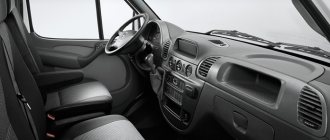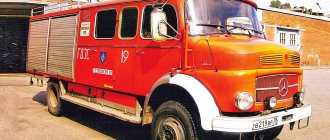Alternative Sprint
Andrey Filippov, photo by the author
| Manufacturer: | Daimler AG |
| Model: | Mercedes-Benz 316 NGT Sprinter |
| Start of sales in Russia: | 2010 |
| Price: | RUB 1,750,000 |
The topic of using methane as an alternative fuel has been followed by our editors for a long time. We have already tested small cars running on compressed gas with a carrying capacity of only half a ton and a car capable of carrying more than two tons. The turn of our most popular class “one and a half” has come. Although, to be completely honest, our MB 316 NGT Sprinter takes on board only two hundred tons, but there are even more serious equipment in its line. So it is quite suitable for the test.
Mercedes-Benz Sprinter 316 NGT
Mercedes-Benz Sprinter 316 NGT
Mercedes-Benz Sprinter 316 NGT
If it weren’t for the painted sides of this Sprinter, perhaps no one would have paid attention to it - “three hundred and sixteenths” are not uncommon on the road. But I know: this car is unusual. The fact is that its dual-fuel engine is equally well suited to run on gasoline and compressed gas. Moreover, there is no preference for one thing - I mean the engine. My point is obvious: gas, of course! The argument in its favor is simple and iron-clad - fuel costs are cut by more than half!
Mercedes-Benz Sprinter 316 NGT
They say that an engine running on gas loses about 15% of its power. This is true when gas equipment is installed on an engine originally designed for gasoline. But natural gas has a much higher anti-knock resistance, so while maintaining the “gasoline” compression ratio (and it, of course, does not change when switching from one fuel to another), it is quite possible to use supercharging.
This technique was used on the bi-fuel Sprinter - the engine was equipped with a mechanical supercharger, and the engine control electronics monitored the coordinated operation of the boost, power supply and cooling systems. In addition, the calorific value of methane is 13,175 kcal/kg, and if we take into account that its density is 0.71 kg/m³, it turns out that one cubic meter contains 9,354 kcal. Gasoline is slightly less “energetic”: it contains 10,572 kcal/kg, or 7718 kcal/l. Hence the greater mileage on gas at the same mass consumption as gasoline.
Mercedes Sprinter 316
The Mercedes Sprinter, so beloved by minibus drivers, received the well-deserved fame of a restyled model called the Mercedes Benz Sprinter 316 in 2000-2006. This maneuverable and well-handled vehicle is suitable not only as a cargo option, but will also become a comfortable vehicle for transporting passengers, because everything in it is designed for increased personal convenience.
The Mercedes Sprinter 316 CDI is equipped with a fairly powerful engine, the volume of which is 2.2 liters and a power of 156 l/s. Thanks to the six-speed gearbox, the car's maneuverability and controllability have become much better, especially in intercity transport conditions.
In addition, at the request of the client, the Sprinter can be equipped with an automatic transmission, only it will be five-speed. a Mercedes Sprinter 316 , so impressive and modern, appears in your fleet
The maximum capacity of the Sprinter is up to 17 seated passengers and up to 26, including standing ones. But we understand that no one will ride standing in such a comfortable cabin, because it is much better to sink into soft chairs of an anatomical design with pleasant fabric upholstery. You can take a nap in this chair during a long journey.
Not only the seats inside the cabin are conveniently arranged, but also the armrests that are on the seats on the aisle side, and with air conditioning, even the hottest day will fly by unnoticed. Such a car is suitable not only for business, but will also be appropriate as a family minivan, especially if your family includes many relatives. In addition, the Germans also took care of safety by adding two fire extinguishers, two hammers and a first aid kit to the car.
The new model also has an independent front suspension, and shock absorbers and stabilizers on the rear suspension make potholes and potholes on the roads minimally noticeable.
The Mercedes Sprinter 316 is good for everyone, its load capacity ranges from 1 ton 500 kg to 1700 kg, there are several wheelbase options - long, medium and short, as well as two roof options - low with a height of 1630 mm and high - 1850 mm. That is, you can drive in a modification of the car with a high roof and standing, but in this case you need to be careful, any fall can lead to injury.
The exterior of the car is also well thought out: slanting “eyes” - headlights, a shiny logo, a successful radiator grille, all this speaks of the little things that the Mercedes manufacturer has carefully prepared for you.
Both the gas fitting and the gasoline filler are located under one hatch.
Both the gas fitting and the gasoline filler are located under one hatch.
Both the gas fitting and the gasoline filler are located under one hatch.
Only for storing gas compressed up to 200 atm on board, appropriate containers are needed. There are six of them: three steel cylinders across under the rear overhang and three along the base, with a total volume of almost 300 liters. This hardware weighs a lot - together with associated equipment, 335 kg, but for a fairly large car this is not so significant. But the range on gas and gasoline (there are 100 liters in the tank) is 1000–1200 km.
There are nine seats in the cabin, including the driver’s, which formally allows the owner of category B to drive the car. But if you sacrifice a little comfort and arrange the seats in a businesslike manner, like in a Gazelle minibus, then twice as many passengers will enter. At the same time, you can walk along the remaining corridor at full height - the ceiling is high.
The driver's workplace is organized very conveniently (in a Mercedes it can't be any other way!). There are a minimum of buttons and knobs that are so fashionable in modern cars, but everything you need is there, and exactly where it should be. The compact gear lever “grows” from the instrument panel, and you can easily walk into the cabin from behind the steering wheel.
Horse - methane fire
This was my longest and most varied drive with a gas-powered car. I managed to bump into Moscow traffic jams, take a ride along the Dmitrovskaya highway, which, after the Leningradka was closed for trucks, became the NEW Leningradka with all its snail’s speed. I drove from Moscow to the very border with Belarus, and then enjoyed the magnificent roads of the fraternal country. The circle covered about 3000 km, which is quite enough for some conclusions.
The first impression is that an empty van simply does not move. In the usual range of 1900–2500 rpm, the Sprinter is more like a stayer. Smooth acceleration, mediocre acceleration, in general, some kind of slow-moving vehicle. Test cars usually try to pack as much as possible, so I’m simply unaccustomed to engines of less than 2.0–2.5 liters in vans of this class. I would have continued to grumble dissatisfiedly under my breath that I couldn’t tear myself away from the flow, if my colleague Pavel Gamankov hadn’t read the technical data sheet more carefully, and there... The engine displacement is 1796 cm3.
After such a “discovery,” the topic of low power was closed forever. The gas pedal is closer to the floor, the tachometer needle is in the range from 3000 to 4000 rpm, and where is that flow? That's right, in the magnificent mirrors of the current MB Sprinter. The only difference from the diesel engine is that you have to move the gearbox joystick more actively.
By the way, all the main parameters were also applied to the windshield, and how could I not notice them... But for those who are wondering how you can drive with inscriptions on the glass, I answer - great. The gaze usually focuses much further and the driver simply does not notice the letters.
I also had a chance to drive on gasoline, although only a little, about 150 kilometers. There are no special advantages or disadvantages. Personally, I could not determine by the sensations what you were driving. Dynamics, noise and vibration comfort are all absolutely the same.
The MB Sprinter has a full 100 liter tank, for which special thanks to the designers. For Russia, just right, but if it were smaller, I might not have risked exploring the gas route to the border with Europe.
But there was no spare tire. Risk, of course, is a noble cause, but upon departure I still bought a bottle of sealant, and on the way back from Minsk I also forked out money for a pump. I once again recommend that potential buyers do not save money and immediately buy a spare wheel - it will be more reliable this way.
Finally, let me clarify that the gas in the cylinders is enough for 496 km in highway mode, which is quite enough for interregional transportation.
Technical characteristics of MB 316 NGT Sprinter 906KA35
| Total weight, kg | 3500 |
| Curb weight, kg | 2235 |
| Load capacity, kg | 1265 |
| Permissible load on the 1st/2nd axle, kg | 1650/ 2250 |
Engine:
| M271 E18 ML, gas/petrol, I-4 1796 156 at 5000 min-1 240 at 3000–4000 min-1 |
Transmission:
| NSG 370, mechanical 6/ 1 |
| Suspension | Spring |
| Brake system | Adaptive ESP, ABS, ASR, BAS, EBD |
| Wheel formula | 4x2 |
| Minimum turning radius, m | 13,6 |
| Fuel tank capacity, l | 100 |
| Capacity of gas cylinders, l | 208 |
Removing the seats and turning the interior into a cargo van is a matter of minutes.
Removing the seats and turning the interior into a cargo van is a matter of minutes.
Removing the seats and turning the interior into a cargo van is a matter of minutes.
Everything is spacious and at the same time functional, like a bus. The same bus manners on the move. Fussy changes from row to row do not suit such a car, although if desired, they can be done without difficulty - visibility in all directions is excellent, the speakers are sufficient whether on gas or gasoline, and the suspension does not allow threatening rolls. It is impossible to detect the transition from one fuel to another and any changes in the behavior of the car.
The press release and fellow journalists claim that the effect was achieved thanks to the sequential rather than one-time transition of the cylinders to another fuel. Could it really be any other way? There is an order of operation of the cylinders, which prescribes the order. It can't be done faster than two revolutions of the crankshaft. You can determine what the engine is running on only by using the “gas-gasoline” button on the instrument panel. By the way, the start-up, regardless of its position, occurs on gasoline, followed by automatic switching to gas if this particular mode is selected.
The only external difference from the regular Sprinter, except for the NGT (Natural Gas Technology) nameplate on the rear door, is the spare tire in the cabin, nestled in the corner behind the last row of seats. Its regular place under the rear overhang is occupied by gas cylinders. But it seems that the standard equipment does not include a spare tire at all: in the box under the passenger seat there is a repair kit for express tire repair - a can of sealant and a compressor.
The lid lifts...
Gas equipment is installed at the factory, so lifting the hood and looking under it is not fun. The motor is just like a motor, no noticeable differences. It's better to immediately look under the bottom. All the cylinders are there, under the reliable protection of metal boxes. Moreover, they are placed in such a way that you can only see those in the base by crouching to the ground. So the MB Sprinter is not afraid of road bends and inspection holes. True, the rear overhang, or rather the protection, is a little long and can hit the ground on steep exits, but the van doesn’t pretend to be an all-terrain vehicle.
The cylinders are made not of composite material, but of metal. Representatives of the plant say that the metal is more ductile and therefore more reliable in case of accidental damage. In addition, although the container is heavier, it is less expensive. The filler necks are located on one side and covered with a standard hatch, pressed against the door. For me it’s very convenient. There is no need for separate lids with locks; a plastic cap on the fitting is enough. And there is no need to make extra runs around the van. Again, the pocket for the adapter in the driver’s door comes in handy.
A few words about the fuel scale. It is very difficult to work with, and it is reckless to rely on it 100%. After refueling in the heat or when driving in a traffic jam, one bar is enough for only 18 km, which is simply terrifying at first. But as soon as you refuel on a cool morning, when the gas occupies a smaller volume and more of it enters the cylinders, or drive along the highway, the same division will go out only after 40 km. In addition, if in diesel versions all divisions are tied to the same amount of fuel and mileage, then the last two columns (there are ten in total) in the gas version disappear unexpectedly quickly. Moreover, the blinking of the last one lasts only 4 km, after which it goes out, but the car still drives for some time on the remaining gas - a very strange setting.
Otherwise everything is transparent. The switch to gas is carried out automatically as the engine warms up, but there is also the good old NGT button - for forced selection of the type of fuel, which I unsuccessfully searched for on other cars. What the MB Sprinter is driving at a particular moment can be easily determined by the light on the NGT button or by the above-mentioned scale, in the window on the panel one or another row of columns turns on. When the gas runs out, a yellow cylinder symbol appears on the panel.
That's all the main differences between the MB Sprinter NGT.
In the factory configuration, instead of a spare tire, there is a repair kit, but its capabilities are very limited.
In the factory configuration, instead of a spare tire, there is a repair kit, but its capabilities are very limited.
In the factory configuration, instead of a spare tire, there is a repair kit, but its capabilities are very limited.
I note that the spare tire is still more reliable - as soon as I tried to try on the compressor, its tip fell apart right in my hands. Wasn’t this accessory ordered from a Chinese cooperative? The spare tire, even if it takes up space in the cabin, instills much more confidence. However, this does not apply to the features of a gas-cylinder car.
Mercedes-Benz Sprinter 316 NGT: packed lunch










